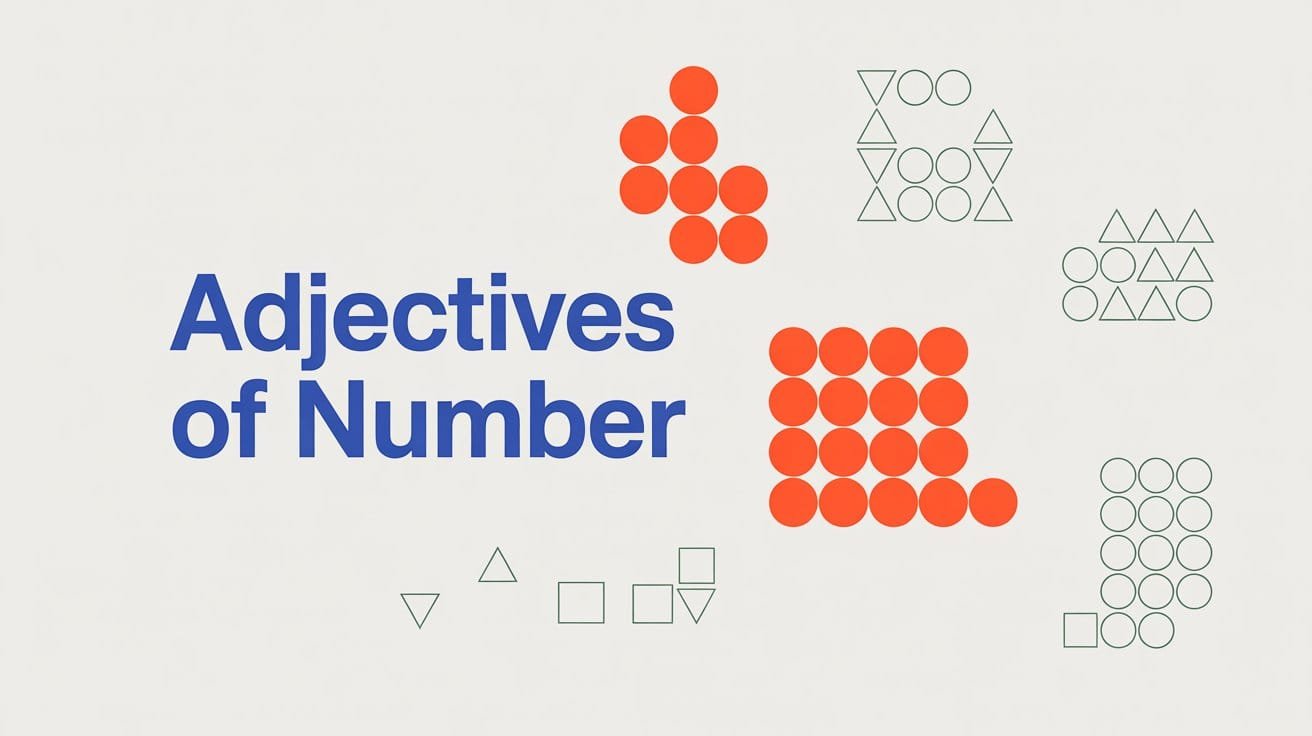In English grammar, adjectives do more than just describe things—they help us quantify, compare, and clarify. One specific kind, known as adjectives of number, tells us how many people or things we’re referring to or in what order they appear.
Whether you’re saying “three books,” “every student,” or “first prize,” you’re using an adjective of number. These words give structure to your sentences and make your meaning more precise.
In this guide, we’ll look at the different types of adjectives of number, how they’re used, and how they differ from other adjectives like those of quantity or description.
Definition of Adjectives of Number
Adjectives of number describe how many or in what order nouns appear. They are always used with countable nouns and help answer the questions:
- How many?
- Which one is in a sequence?
These adjectives don’t describe the quality of something—they focus entirely on count or sequence.
Examples:
- She has two notebooks in her bag.
- He came third in the race.
- Each child received a gift.
Adjectives of number are essential for giving clear, structured information—whether you’re counting items, distributing tasks, or identifying order.
Types of Adjectives of Number
Adjectives of number are grouped into three main types, based on how they describe quantity or order.
1. Definite Numeral Adjectives
These give an exact number or specific position.
- Cardinal Numbers (count): one, two, ten, hundred
Example: We adopted two kittens from the shelter. - Ordinal Numbers (position or rank): first, second, fifth, last
Example: She finished in second place. - Multiplicative Numbers (multiples): single, double, triple
Example: The recipe calls for a double portion of sauce.
2. Indefinite Numeral Adjectives
These refer to an uncertain or general number. They don’t tell you exactly how many but still indicate quantity.
Common examples: some, many, several, few, all, most, enough
Example: Several guests arrived early for the event.
3. Distributive Numeral Adjectives
These refer to individual members of a group, one at a time or in pairs.
Common examples: each, every, either, neither
Example: Each participant must complete the form.
Usage Rules for Adjectives of Number
To use adjectives of number correctly, it’s important to understand where they go in a sentence and how they behave with countable nouns.
1. Used Only with Countable Nouns
Adjectives of number always describe things that can be counted.
✔ She bought three apples.
❌ She bought three milk. (Incorrect — “milk” is uncountable)
2. Placed Before the Noun
These adjectives typically appear right before the noun they modify.
✔ He solved five problems in one hour.
✔ Every student received a welcome kit.
3. Maintain Subject-Verb Agreement
The verb in the sentence must agree with the subject’s number.
✔ Each player has a locker.
✔ Two students were absent today.
4. Avoid Repetition of Number Words
Don’t use multiple number adjectives unnecessarily.
❌ He finished in first and second position. (Logically incorrect)
✔ He finished in first position.
Examples of Adjectives of Number in Sentences
These examples show how different types of number adjectives work in real sentences.
Definite Numeral Adjectives
- She owns four bicycles.
- We climbed to the seventh floor.
- The team scored a double win this season.
Indefinite Numeral Adjectives
- Many students stayed after class.
- Several books were missing from the shelf.
- Few people understood the instructions.
Distributive Numeral Adjectives
- Each child was given a balloon.
- Every room in the house was painted.
- Neither answer was correct.
Adjectives of Number vs. Adjectives of Quantity
These two types of adjectives are often confused because they both relate to amount, but there’s a clear difference:
Adjectives of Number refer to countable nouns and answer “How many?” or “Which one?” They specify exact numbers, order, or distribution. For example, “She read three articles.”
Adjectives of Quantity refer to uncountable nouns and answer “How much?” They give an idea of the amount without counting.
Examples:
- He drank some water.
- We have enough information.
- There was little hope left.
Quick Comparison:
| Feature | Adjective of Number | Adjective of Quantity |
|---|---|---|
| Works with | Countable nouns | Uncountable nouns |
| Answers the question | How many? / Which one? | How much? |
| Examples | two, third, several | some, little, enough |
FAQs About Adjectives of Number
What is an adjective of number?
An adjective of number is a word that tells how many people or things are being referred to, or in what order they appear. Examples include two, first, each, and several.
How are adjectives of number different from adjectives of quantity?
Adjectives of number are used with countable nouns (e.g., “three apples”), while adjectives of quantity are used with uncountable nouns (e.g., “some water”).
Can adjectives of number be both definite and indefinite?
Yes. Definite adjectives of number refer to exact numbers or positions (e.g., four, second), while indefinite ones refer to general amounts (e.g., many, several).
What are distributive numeral adjectives?
Distributive numeral adjectives refer to individual items in a group, such as each, every, either, and neither. They emphasize members separately rather than collectively.
Is “few” an adjective of number or quantity?
“Few” is considered an indefinite numeral adjective when it refers to a countable number of things. It describes number, not quantity.



